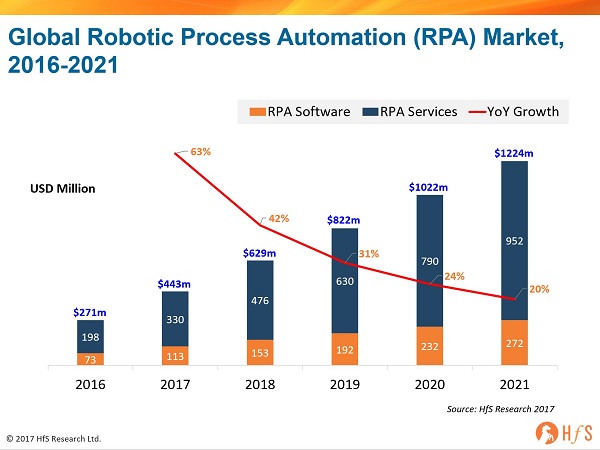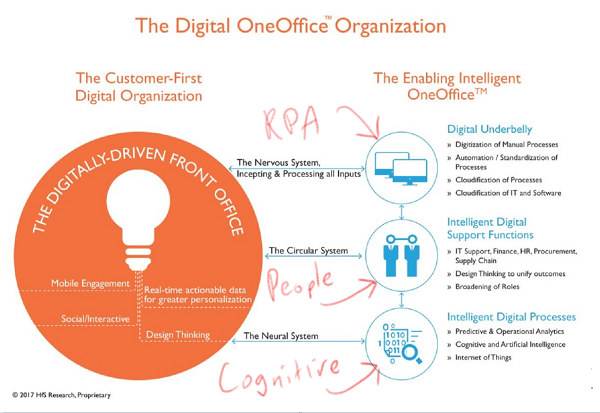Have we ever got so excited about a market that isn’t even yet past the half-billion dollar spend level? Are we getting over excited about solutions because of their potential before they are fully tried and tested in reality? Let’s get to the realities of RPA by examining the size and five-year forecast for software and related services expenditure:

The global market for RPA Software and Services reached $271 million in 2016 and is expected to grow to $1.2 billion by 2021 at a compound annual growth rate of 36%. The direct services market includes implementation and consulting services focused on building RPA capabilities within an organization. It does not include wider operational services like BPO, which may include RPA becoming increasingly embedded in its delivery.
RPA describes a software development toolkit that allows non-engineers to quickly create software robots (known commonly as “bots”) to automate rules-driven business processes. At the core, an RPA system imitates human interventions that interact with internal IT systems. It is a non-invasive application that requires minimum integration with the existing IT setup; delivering productivity by replacing human effort to complete the task. Any company which has labor-intensive processes, where people are performing high-volume, highly transactional process functions, will boost their capabilities and save money and time with robotic process automation. Similarly, RPA offers enough advantage to companies which operate with very few people or shortage of labor. Both situations offer a welcome opportunity to save on cost as well as streamline the resource allocation by deploying automation.
The bottom-line: RPA provides the building blocks for digitizing rudimentary processes in the digital underbelly, but the broader market for intelligent process automation is more than 10x the size
Stay tuned for our broader forecast for the global Intelligent Process Automation market, which is in the final stages of its fine-tuning, as the expenditure enterprises and service providers are making their internal teams to learn how to automate business processes intelligently, the internal training and development, pilot projects and trial implementations, is so much larger than simply software licences and third party professional services to work the software effectively.
Net-net, we have to be realistic about the value RPA brings to enterprises today, versus its potential for the future. RPA’s value for most of today’s early adopters lies in the digitizing of rudimentary manual processes. It’s a starting point for designing the underbelly that enables a digital OneOffice environment:

Digital effectiveness is all about organizations enjoying real-time process flows forged through the elimination of manual process break-points and intelligent linking of data patterns across the front and back offices. RPA is a critical building block in facilitating this journey, but ultimately it’s the whole OneOffice, not the sum of the parts, that matters for true real-time effectiveness. This is about one integrated organization unit, where teams function autonomously across front, middle and back office functions and processes to promote real-time data flows and rapid decision making, based on meeting defined outcomes. In the future… front, middle and back offices will cease to exist, as they will be, simply, OneOffice, and RPA has a critical role to play supporting the building blocks. However, the market is still very young and we’re only at the start for so many organizations, so let’s not get too carried away until we see really robust solutions with proven ROI and long-term business value.
In short, every siloed dataset restricts the analytical insight that makes process owners strategic contributors to the business. You can’t create value – or transform a business operation – without converged, real-time data. Digitally-driven organizations must create a Digital Underbelly to support the front office by automating manual processes, digitizing manual documents to create converged datasets, and embracing the cloud in a way that enables genuine scalability and security for a digital organization. Organizations simply cannot be effective with a digital strategy without automating processes intelligently – forget all the hype around robotics and jobs going away, this is about making processes run digitally so smart organizations can grow their digital businesses and create new work and opportunities. This is where RPA adds most value today… however, as more processes become digitized, the more value we can glean from cognitive applications that feed off data patterns to help orchestrate more intelligent, broader process chains that link the front to the back office. In our view, as these solutions mature, we’ll see a real convergence of analytics, RPA and cognitive solutions as intelligent data orchestration becomes the true lifeblood – and currency – for organizations.
Posted in : Cognitive Computing, Robotic Process Automation







Phil, what are your thoughts on which domain/ industry is leading the charge in RPA market share? YAnd how do you see it evolving over the next few years? And similarly how’s IA going to evolve for these industries.
Finally, a number I can quote with confidence. Great insight and clarity from the team that’s had their finger on the pulse of RPA since the beginning. Thanks Phil and Jamie Snowdon!
@Sanyog – see [here](http://www.horsesforsources.com/storage/app/media/Phil/IT%20sector%20most%20active%20.jpg) for industries from our state of outsouring study. Energy, banking, insurance, manufacturing leading RPA adoption interest. Industries where cost shaving is king and offshore outsourcing very mature. Main processes under RPA review are F&A, claims processing, banking specific work… emerging are payroll, recruiting, procurement.
Cognitive / machine learning is on the uptick as many firms realize their options are limited with RPA, but the focus on cognitive is much more aligned to value that direct headcount elimination. As I point out here, RPA streamlines (via digitization) the rudimentary underbelly, but it’s the intelligent liniing of data patters through smart algorithms which is where the real value lies down the road. This is the intrinsic linkage between RPA and congitive. You can’t do digital withouth RPA, and you can’t to cognitive without digital…
The platforms? Blue Prism has the most mature partner ecosystem, but hats off to UIPath for it’s investment raising and competitive model. Automation Anywhere has been very active in F&A process and growing fast, but its financial footing is less clear for the future and clients stuggle with central control and governance over these environments. All three products offer strong bot building recording capabilities, and all three have differing pricing and partnering strategies. Redwood is interesting as it focuses on developing bots to fix manual breakages in SAP environments, but it’s partnering with the advisor channel less clear. Pega is quietly developing a stella orchestration engine which contains RPA and Workfusion has a freeware version which is being trialed by some firms. Check out the landscape [here](http://www.horsesforsources.com/RPA-provider-blueprint-snapshot_022217).
In general, RPA software firms are claiming – and demonstrating – some client cases where ~40% of cost (or more, in some cases) is being taken off the bottom line. While some of these cases are genuine, there are many RPA pilots and early-phase implementations in the industry that have been left stranded because clients just couldn’t figure out the ROI and how to implement this stuff. This isn’t simply a case of buying software and looping broken processes together to remove manual efforts… this requires real buy-in from IT and operations leaders to invest in the technical, organizational change management, and process transformation skills.
Did companies become world class at HR overnight because they bought an expensive Workday subscription? Or stellar at sales and marketing because they slammed in a Salesforce suite? So why should they become amazing at cost-driven automation simply because they went and bought some licenses from an RPA vendor promising bot farms and virtual labor forces?
RPA and Intelligent Automation have sparked a major war in the worlds of outsourcing and operations, where many battles are being fought – and the winners will be those who are in this for the long haul, who can absorb some short-term pain in order to benefit from the larger spoils further down the road. While automation is killing outsourcing today – costing many people their jobs, their reputations and destroying the profitability of legacy engagements, those who can hunker down, focus on self-contained projects where they can fix one broken process at a time, can get stakeholders onside by demonstrating meaningful, impactful outcomes without major resource investments, will be the winners. Start with one process at a time, prove how to fix in, then onto the next, then the next… that is the only true way to be successful in this destructive automation-infested world.
PF
Very interesting numbers Phil. Probably the most realistic I have seen so far.
Arturo Clark
Good data, Phil – and a good synopsis too,
Peter
The future is challenging & unknown. How much RPA & AI “Mimics an Expert” & the applied learnings will determine the development course/milestones. As the millennials lap these advances as normal, believe me though being in the IT industry for the past 30 years, I am sure it would leave me astounded in the years ahead. As with all discoveries & advances, the option I not about acceptance, but how well we integrate these in our daily life for fulfillment. Cheers to the IT industry.
Hi Phil,
Do you see the adoption of Bots as a bridge to Gap a Tool’s or Applications’ capability? i.e. a bot doing an activity where product enhancement is not the best option. Eg: A Bot to do 2/3 way matching whilst processing an Invoice OR a Bot to onboard suppliers based on a manual form outside of the Procurement tool OR Bot to do catalog maintenance, etc.
I would love to see this market size graphic with RDA, Cognitive and AI growth layered on top so that I could see how to invest in my business through 2025 with an eye toward all key technologies. As always – great work guys
Useful numbers
thanks